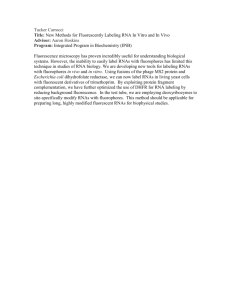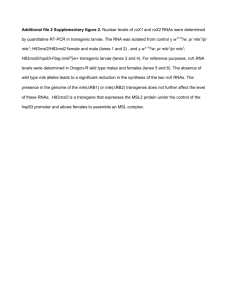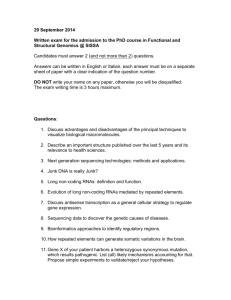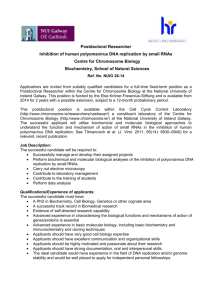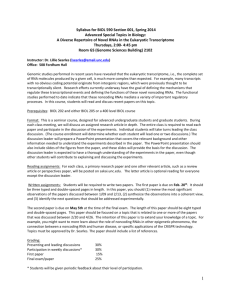Supplementary Figure Legends - Word file (30 KB )
advertisement
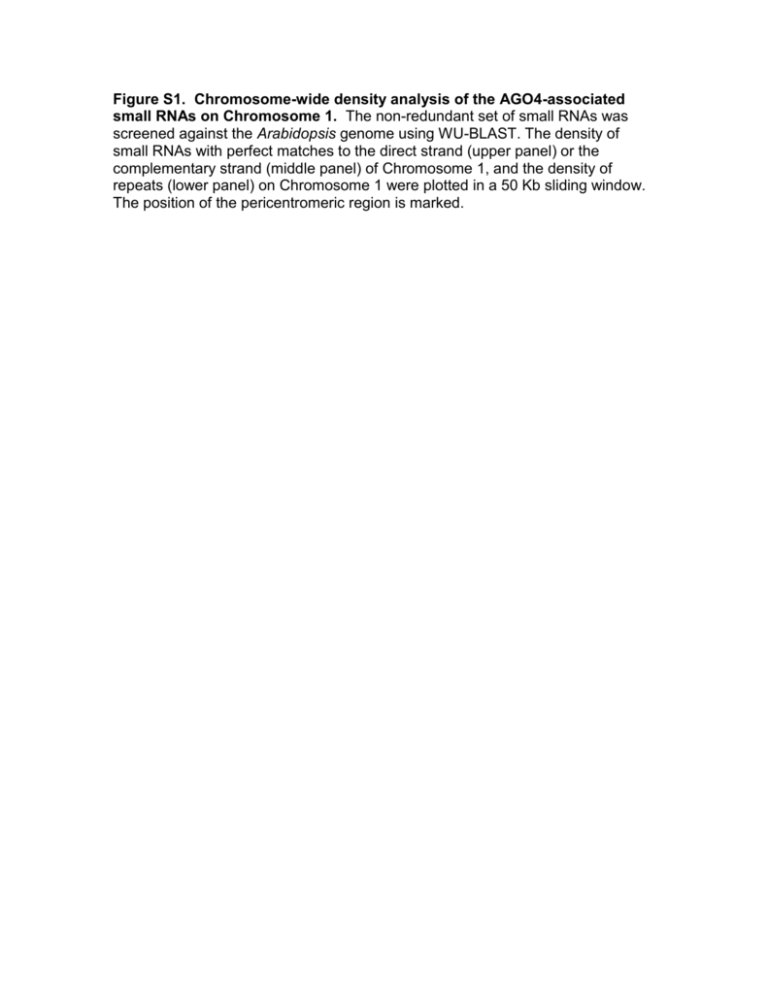
Figure S1. Chromosome-wide density analysis of the AGO4-associated small RNAs on Chromosome 1. The non-redundant set of small RNAs was screened against the Arabidopsis genome using WU-BLAST. The density of small RNAs with perfect matches to the direct strand (upper panel) or the complementary strand (middle panel) of Chromosome 1, and the density of repeats (lower panel) on Chromosome 1 were plotted in a 50 Kb sliding window. The position of the pericentromeric region is marked. Figure S2. Chromosome-wide density analysis of the AGO4-associated small RNAs on Chromosome 2. The non-redundant set of small RNAs was screened against the Arabidopsis genome using WU-BLAST. The density of small RNAs with perfect matches to the direct strand (upper panel) or the complementary strand (middle panel) of Chromosome 2, and the density of repeats (lower panel) on Chromosome 2 were plotted in a 50 Kb sliding window. The position of the pericentromeric region is marked. 2 Figure S3. Chromosome-wide density analysis of the AGO4-associated small RNAs on Chromosome 3. The non-redundant set of small RNAs was screened against Arabidopsis genome using WU-BLAST. The density of small RNAs with perfect matches to the direct strand (upper panel) or the complementary strand (middle panel) of Chromosome 3, and the density of repeats (lower panel) on Chromosome 3 were plotted in a 50 Kb sliding window. The position of the pericentromeric region is marked. 3 Figure S4. Chromosome-wide density analysis of the AGO4-associated small RNAs on Chromosome 5. The non-redundant set of small RNAs was screened against the Arabidopsis genome using WU-BLAST. The density of small RNAs with perfect matches to the direct strand (upper panel) or the complementary strand (middle panel) of Chromosome 5, and the density of repeats (lower panel) on Chromosome 5 were plotted in a 50 Kb sliding window. The position of the pericentromeric region is marked. 4 Figure S5 Preferential association of a subset of microRNAs with AGO4. a. Data obtained from 454 sequencing were used to quantify levels of individual miRNAs, relative to total miRNA content, in AGO1 and AGO4 complexes and in total RNA. Percent contribution for a subset of microRNAs with preferential association with either AGO1 or AGO4 is shown graphically. b. Northen analysis of miR172, miR163, miR390, and miR173 confirm patterns of AGO1 and AGO4 binding discerned from sequencing. siRNAs from AtSN1 and tasiRNA480 are shown as controls for AGO4 and AGO1-bound species, respectively. 5 Figure S6 Identification of AGO4-regulated loci through small RNA sequencing. a, Northern analysis of small RNAs in total RNA and in RNAs isolated from TAPAGO4 and control purifications were performed using the indicated probes. Radioactive RNAs of known sizes were included as size markers. b, Northern analysis of AtREP1/2 and SIMPLEHAT2 siRNAs were performed on RNA from the indicated plants. miR171 serves as a loading control. c, Analysis of CpG (left), CpNpG (center), and CpHpH (right) methylation at ATREP2 and SIMPLEHAT2 loci was carried out by bisulfite sequencing of genomic DNA prepared from the indicated plants. The methylation level is shown by the percentage of methylated cytosine in all sequenced clones. Data in Table S6 were used to generate the histograms. 6 Figure S7. Accumulation of AGO4 wild-type and DDH mutant proteins in transgenic Arabidopsis plants. Total proteins were extracted from pooled samples of ~30 T1 transgenic lines for each constructs. Western blot analysis was performed using anti-myc antibody. The position of myc-AGO4 is indicated by the arrow. The lower band is a cross-reacting species seen in all samples. 7 Figure S8. AGO4-mediated cleavage of miRNA targets. AGO4 complexes or control immunoprecipitates were mixed with labeled, synthetic target RNAs for two AGO-4 associated microRNAs, miR390 and miR172 (TAS3 and AP2 mRNA, respectively). Cleavage was monitored by electrophoresis of reaction products. 8 Figure S9. Analysis of CpG (left), CpNpG (middle), and CpHpH (right) methylation at SUP, AtMu1, MEA-ISR and ATREP2 loci in T2 transgenic lines. Bisulfite sequencing data from two biological replicates were combined. Methylation levels are shown by the percentage of methylated cytosines in all sequenced clones. Data from Table S8 were used to generate the histograms. 9 Figure S10. Northern blot analysis of siRNAs derived from MEA-ISR, AtSN1, and ATREP2 in RNAs prepared from the indicated T2 plants. miR171 was used as a loading control. The siRNA signals were normalized relative to miR171 and the relative levels were calculated by comparison to those in clk-st (see text, arbitrarily set to 1). 10
